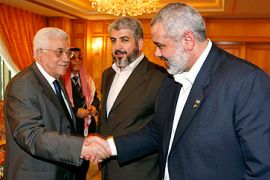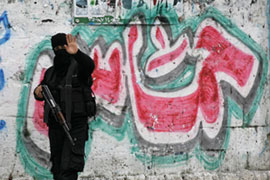Timeline: The West Bank-Gaza split
Build up to the break between the Fatah and Hamas administrations.

 |
| Scores of Palestinians were killed in clashes between fighters [AFP] |
2006
January 25: Hamas wins Palestinian general elections gaining 76 of 132 seats.
January 29: Western governments threaten to halt financial aid to Palestinians.
January 30: The Quartet group (the UN, EU, US and Russia) announces “all members of a future Palestinian government must be committed to non-violence, recognition of Israel, and acceptance of previous agreements and obligations”.
March 18: Hamas submits its cabinet to President Mahmoud Abbas (24 ministers including eight MPs). In response, the US, EU, and Israel boycott the new government and say they will suspend aid to the government.
April 16: Iran announces an offer of $50m in aid to the Palestinian Authority.
May 8: Three Palestinians killed and 10 wounded in clashes in southern Gaza, near Khan Yunis, between rival Hamas and Fatah supporters.
May 17: Hamas deploys a new 3,000-strong force on the streets of Gaza.
May 11: Prominent Palestinian prisoners in Israeli jails release a document calling for a national unity government between Hamas and Fatah.
June 3: A new security force loyal to Abbas is deployed in the West Bank.
June 16: The EU endorses a new policy to channel aid directly to the Palestinians, bypassing Hamas.
June 25: Palestinian fighters launch an attack in Israel that results in the deaths of two Israeli soldiers and the capture of another, Corporal Gilad Shalit.
June 27: Hamas and Fatah reach an agreement based on the prisoners’ document which includes the forming of a national unity government.
 |
| Israel has repeated incursions into Gaza, killing hundreds of Palestinians [AFP] |
June 28: Israel launches Operation Summer Rains in what it says is an attempt to recover the captured soldier. The ongoing operation initially consists of heavy bombardment of bridges, roads, and the only power station in Gaza. Hundreds of Palestinians are killed during aerial and ground attacks over the following months.
June 29: Israel detains 64 Hamas officials, including eight Palestinian Authority cabinet ministers and up to 20 members of the Palestinian Legislative Council.
September 1: Abbas says Hamas and Fatah have agreed on the principles of a power-sharing government and may soon form a new cabinet to lead the Palestinian Authority. Under the plan, Abbas is to dissolve the current Hamas-led cabinet within 48 hours.
September 8: UN officials say Gaza is at “breaking point” after months of economic sanctions and Israeli attacks.
September 23: The agreement breaks down, with Hamas’s refusal to recognise Israel reportedly at the heart of the continued disagreements.
October 1: Eight people are killed in Gaza in factional fighting between Hamas and Fatah as a new wave of violence erupts.
October: A number of mediation attempts take place. Egypt and Qatar send their foreign ministers to meet both sides. Other Palestinian groups such as Islamic Jihad and the Popular Front for the Liberation of Palestine mediate between the two sides to stop the clashes.
November 13: Following talks between Hamas and Fatah, both sides agree to form a government of technocrats unaligned with either movements. Muhammad Shbeir, a Gaza academic who is close to Hamas but not a party member accepts, the offer to head the government.
November 14: Hamas again reiterates that it will not recognise Israel and the agreement stalls.
December 15: Hamas accuses Fatah of involvement in a gun attack on the Ismail Haniyah, Palestinian prime minister, as he crosses the border from Egypt into Gaza.
December 16: Abbas calls for new elections as a solution to the ongoing crisis.
2007
 |
| The two sides finally reached agreement at the Mecca summit in February [AFP] |
January 21: Abbas meets Khaled Meshaal of Hamas in Damascus in response to an invitation by Bashar al-Assad, the Syrian president.
January 30: Fatah and Hamas reach a ceasefire agreement mediated by Egypt after a series of clashes lead to the death of 32 Palestinians. Both sides welcome a Saudi initiative to meet in Mecca.
February 8: Hamas and Fatah agree a deal in Mecca to end factional warfare that has killed scores of Palestinians and to form a coalition, hoping this would lead Western powers to lift crippling sanctions imposed on the Hamas-led government.
February 9: The Quartet welcomes the role of the Kingdom of Saudi Arabia in reaching the agreement to form a Palestinian National Unity government but later reaffirms that it must obey international demands to recognise Israel, renounce violence and abide by previous peace agreements.
February 15: Haniyah and his cabinet resign. Haniyah is re-appointed by Abbas and begins the process of forming a new Palestinian unity government.
March 15: Palestinians reach agreement on the formation of the government.
March 20: Jacob Walles, the US consul-general to Jerusalem, meets Salam Fayad, the Palestinian finance minister, marking the first contact between the US and the recently formed Palestinian unity government.
March 21: EU and UN hold talks with non-Hamas cabinet ministers.
March 22: Fighting erupts again between Hamas and Fatah fighters, with one Fatah fighter killed and seven people injured.
April 10: US announces it is to give Abbas $60m to boost his presidential guard and for other security expenses.
April 23: Hani al-Qawasmi, the interior minister, resigns, saying that there is resistance to his planned reforms for the security services.
April 24: The Izz al-Din al-Qassam Brigades, the military wing of Hamas, fires scores of missiles into Israel, saying a truce “no longer exists”, but the Hamas-led Palestinian government calls for the truce to be restored.
 |
| The unity government deployes a joint police force to combat lawlessness in Gaza [Reuters] |
April 30: Palestinian teachers hold one-day strike over unpaid wages prompting Azzam al-Ahmad, the deputy prime minister and a member of Fatah, to suggest that the unity government be disbanded if the Western embargo is not lifted.
May 10: Unity government deploys a joint Hamas-Fatah police force to deal with growing lawlessness in Gaza
May 11: Clashes erupt between Fatah and Hamas factions.
May 13: Factions agree to a truce, brokered by Egypt, but skirmishes continue to be reported and ceasefire quickly disintegrates. Over the next few days ceasefires are continually agreed but broken hours later, meanwhile Israel continues to bomb Gaza in response to rockets fired by Hamas fighters.
May 24: Abbas calls for Hamas rockets to be stopped but is rebuffed, as factional fighting continues.
May 30: UN Security Council calls for an “immediate end” to the faction fighting in Gaza.
June 7: Fatah fighter killed, the first person killed in internal fighting in more than two weeks.
June 10: Further clashes between the rival factions leave more dead and scores injured.
June 12: Fatah declares it is withdrawing from the unity government until there is an end to recurring street battles.
June 13: Hamas’s Izz al-Din al-Qassam Brigades, which has gained ground across much of Gaza, orders Fatah security forces to surrender their weapons. The group launches attacks on a number of Fatah bases.
June 14: Abbas sacks the Hamas-led unity government and declares a state of emergency. Haniya defies Abbas and promises the government will continue to function.
June 15: Hamas seizes several senior officials and appears in effective control of Gaza. The group declares an amnesty for Fatah fighters.
June 16: Abbas, in the West Bank, signs a decree allowing a Palestinian emergency government to take office without parliamentary approval. Fayad, an independent parliamentarian, is made prime minister. The Palestinian territories have become split between the West Bank, controlled by Fatah, and Gaza, run by Hamas.